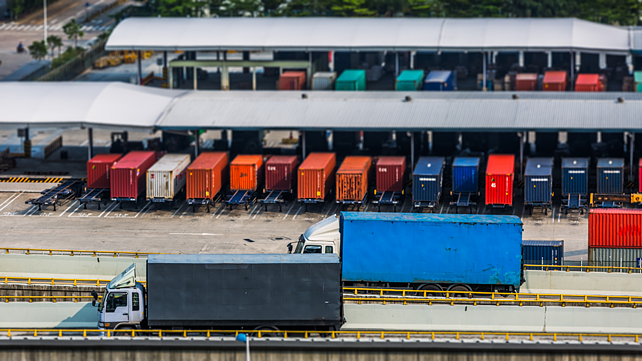
Businesses that depended heavily on human interaction on a daily basis – at the workplace, with clients or with suppliers – hit a bump, when the world was hit by COVID-19 in early 2020. Many businesses suffered losses due to complete lockdowns worldwide. Many countries and cities witnessed closed borders, a shutdown of transport and hence, the transfer of products (mostly non-essential) from one place to the other.
According to a report by the International Finance Corporation titled “The Impact of COVID-19 on Logistics In India”, the lockdown in 2020 created a shortage of truck drivers, which resulted in over 50,000 containers piling up in the ports of Chennai, Kamajarar, and Kattupalli.
This did have an impact on various businesses, including logistics companies.
While this pandemic was a dark cloud for businesses worldwide, it had its silver lining too. COVID-19 motivated businesses to adopt technology to stay in the game. It altered the way businesses operated and introduced a new normal. Companies that witnessed sudden slowdown found innovative ways to do business. Adoption of technology helped them achieve their goals and also, diversify.
For instance, in the logistics business, drivers are the prime players, but they often get neglected. However, technology has changed their position and brought them to the forefront.
Moreover, these technologies have not replaced manpower but have made them more efficient, fast and better connected to the organisation.

Even for the complete supply chain, multiple software have made remote working the ‘new normal’ and seamless. Some of these commonly found software tools include Supply Chain Management (SCM) software, GPS and radiofrequency tools and on-mobile apps. All these tools have been developed over-time utilising technologies such as artificial intelligence, machine learning, internet of things, cloud computing and big data.
We look at some of these technology innovations in the past year to ensure seamless fleet management:
Real-time tracking
Many organisations increased their digital capabilities by implementing technology that could help them track cargo and ensure business online with minimal human interaction with the drivers. These solutions, fuelled by high-end GPS systems, provided tracking and timely deliveries, pre-defined routes for drivers to avoid delivery delays, real-time ETAs (expected time of arrival), and delivery confirmation alerts.
Additionally, mobile applications developed for logistics companies come with services like vehicle management that gives reminders of vehicle servicing, paperwork renewal, and driver or staff’s contract renewal. This ensures that there is no delay in these jobs that are elementary for smooth functioning.
One-button emergency call
Applications have been developed that provide road assistance in case of mechanical breakdowns or mishaps. All these services can be accessed at the click of just one button. Most of the apps developed for logistics companies come with SOS buttons that allow drivers to ask for assistance or help in one click.
Through these apps, help can reach drivers at a faster pace by knowing their real-time location, connecting them to nearby fleets that can provide assistance. SOS alert button also builds the trust in drivers that they will be taken care of in case of emergencies.

Managing documents
Missing, incomplete or damaged documents are one of the prime causes of worry for most logistics companies. This can result in higher numbers of challans issued and seizure of vehicles, which in turn cause a delay in deliveries. With technology, even before a fleet leaves for delivery, all the paperwork can be checked and made available at one place, which can be accessed by both drivers and companies virtually over a mobile application. Drivers can use this app to show their paperwork to the state authorities, whenever the need arises.
To ensure safety of the drivers, most of the delivery vehicles are now mapped using RFID tags. These tags have a unique RFID number for each vehicle that can be scanned using RFID guns at the location of delivery. The scan also gives information such as time spent at the plant, entry time, and order delivery, among others.
Keeping them safe & healthy
Technology also allows companies to ensure their drivers are not fatigued. Apps can provide information such as working hours of a driver and accordingly provide him with a justified schedule. Also, this allows seamless transfer or handover of a job once the shift of a driver is over. It also reminds drivers for regular health check-ups, which ensure that the driver is in a healthy condition.
However, it is also observed that drivers, in order to earn more, push themselves beyond their capacity of work and tend to drive over time. Even this can be tracked online through the mobile app. Today, an organisation can monitor the heart rate of the driver and tell whether or not the driver should push any further.

Training drivers
Safety of the drivers is important when on the road. Road accidents due to bad roads, poor driving skills or fatigue are common phenomena. However, with technology coming into play this can be curbed, lowering the risk of accidents and loss of life. Supply chain companies, with tracking capabilities, can score and alert drivers for good and bad driving skills, respectively.
In case a driver has been driving within set speed limits, not indulging in rash driving or taking sharp turns, they can earn points and be rewarded for good driving behaviour. On the other hand, drivers who indulge in bad driving practices are alerted the moment they do so. Companies can identify such drivers and train them and can also take strict actions if they don’t follow rules even after being trained.
The use of technology has certainly simplified the way the supply chain industry works and has also ensured that the precious manpower involved in this industry is kept safe in these testing times.
About the Author: Vineet Sharma is the Founder & CEO of FleetX.io